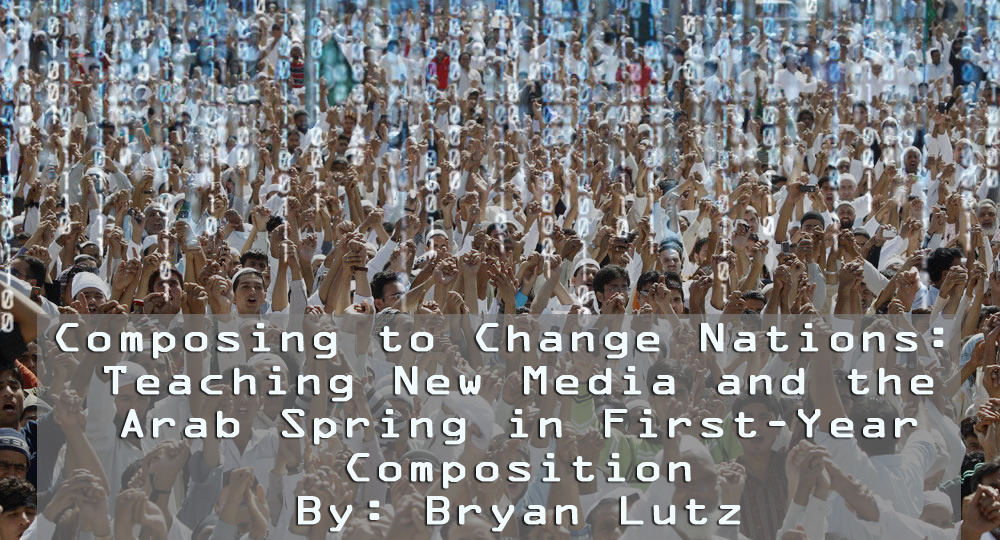Assignment
Goal #3: Global Turns: Combining the University and the Blogosphere
The assignment prompt directs students to find three blogs that discuss their issue. Much like the work of Tryon, students are asked to analyze the arguments contained on the blogs in much the same way they analyze other arguments. They are also asked to identify blogs that invite users to comment in response to their posts. I instruct students to choose blogs not only as sources of information, but also as a chosen audience for their argument. This is where the affordances of social networking are utilized. Blogs usually (though not always) contain ways to interact with the author either through commenting, or by providing the author's email address. Thus students not only have multiple models to draw from for their arguments, but they are also immersing themselves within a social network of ideas, which in itself, has pedagogical utility. As Stephen Downes (2006) argues, “to learn is to immerse oneself in the network…[i]t is to expose oneself to actual instances of the discipline performed, where the practitioners of that discipline are (hopefully with some awareness) modeling good practice in that discipline. The students then, through a process of interaction with practioners, will begin to practice by replicating what has been modeled…providing guidance and correction.” Students often experiment with blog forms based upon what they feel is effective argument within the genre. They will also post their own compositions on other blogs and elicit feedback from those authors. It is the hope of every student that their argument will be well recieved, and this strategy allows students to both test that goal by entering into a rich conversation about real-world problems.
A University provides students with privileged access to discourse communities within the academy. With this in mind the assignment offers substantial workshop time for students to research and find academic sources as a way to investigate the claims made by blog authors. In other words, I ask students to not only to connect with blogs, but to also question them by comparing their arguments to the discourse communities within the academy. This process has exciting implications. Students have access to these databases as part of their tuition, and my assignment makes it mandatory that they included at least two academic sources in their argument. Through the University’s resources students have access to information that is so rarely available to the general public. Databases such as JSTOR or EBSCO cost money to access, which are expenses that are needed to maintain their operation. We of course not sharing entire works, but students decide what parts of their work are relevaent to a public dialogue. Thus, while students are dealing with contemporary issues that the larger public is discussing through their blogs or other news outlets, they also have one extra resource that other bloggers likely do not have access to—the resource of scholars and educators, many of which have spent their lives exploring very specific questions. When properly cited, students are able to share information on a network that otherwise requires a subscription to access. Not only is there potential in this practice to bridge divides between academia and the public, though we acknowledge that a blog essay itself does not answer class divisions that may prevent access to technology for socio-economic reasons (Selfe et. all, 2006), there is potential that a student could introduce an otherwise academic discussion into a more open forum.
In addition, students are asked to use multiple modes to compose their essays and construct meaning. I use both the Allyn and Bacon Guide to Writing and Meltzer and Coxwell-Teague's textbook Everything's a Text to inform much of this practice. As a class we question how images can be used to frame an argument: What is their orientation? Is this a photograph or a rendering? What kind of cultural literacy would an individual need to understand the image? And how does the image frame the argument? We also consider how to incorporate videos from TED, YouTube, or other blogs as a way of both networking information together, and to establish the ethos of someone who has thoroughly researched the issues at hand. We also look at how other blogs use different modalities to construct meaning and make arguments. Many of my students understood how multi-media could help their argument, and on the blog there are numerous examples of this. One student argued how our habits may lead to the next great mass extinction by combining pictures that show the suffering of local wildlife as well as extinction patterns as a compliment to her thoughtful analysis. Another student offered his audiences a direction on our nuclear negotiations with Iran and constructed his ethos as a journalist by using the blog's affordances to make his essay appear like a sophisticated Op-Ed piece. Most of my students express excitement about this aspect of the assignment as a welcome break from the purely alphabetic texts that they are so often asked to compose, and they find some profound ways of constructing meaning by expermienting with their developing awareness of multimodality.
